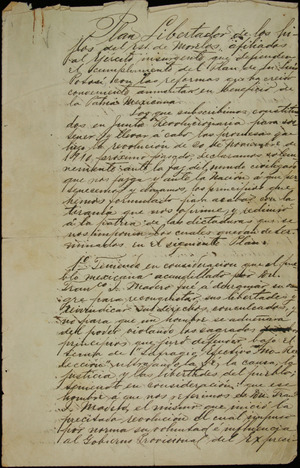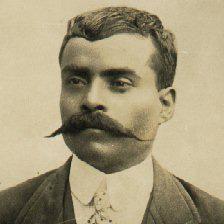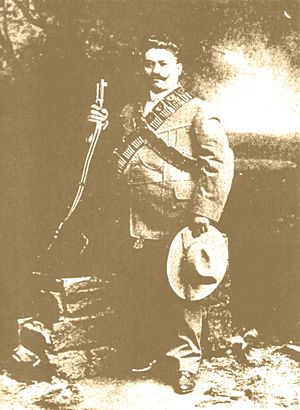Plan of Ayala facts for kids
The Plan of Ayala (in Spanish: Plan de Ayala) was an important document written by the revolutionary leader Emiliano Zapata during the Mexican Revolution. In this plan, Zapata said that President Francisco Madero had not kept his promises. Madero had promised land changes in his own plan, called the Plan de San Luis Potosí. Zapata's Plan of Ayala explained his own ideas for how land should be shared.
The Plan was first announced on November 28, 1911, in a town called Ayala, in the state of Morelos. It was changed a little bit later on June 19, 1914. The Plan of Ayala was a very important paper during the revolution. It also helped shape how land was given out in Mexico in the 1920s and 1930s. It was the main idea for Zapata's followers, known as the Zapatistas.
Why the Plan Was Needed
Before the Mexican Revolution, most of Mexico's good farming land belonged to a few very rich landowners. Regular people did not own much land. These big farms were called haciendas. They often took land from poor farmers and from native communities. Many farmers had to work for these big landowners for very low pay. They did not own land to grow food for themselves or their families. This made many people in the countryside very upset.
Changing who owned the land was one of the main reasons the Mexican Revolution started. This problem also strongly shaped Zapata's ideas in the Plan of Ayala.
Emiliano Zapata was a revolutionary leader from the southern state of Morelos. When the Mexican president, Porfirio Diaz, was overthrown, Zapata joined Francisco Madero. He did this because Madero had promised land changes in his Plan of San Luis Potosí.
On June 8, 1911, Madero met with Zapata. Madero told Zapata that his army had to give up their weapons first. Only then would they talk about land reform. Zapata did not agree. Madero was later elected president on November 6. He then said Zapata was an outlaw because he would not put down his weapons.
On November 28, 1911, Zapata released the Plan of Ayala. He wrote it with help from Otilio Montaño Sánchez. Sánchez was a school teacher in Ayala who met Zapata through his brother. This happened just three weeks after Madero became president.
What the Plan Said
The Plan of Ayala was written with the help of Otilio Montaño Sánchez, a local schoolteacher and Zapata's helper. It clearly showed Zapata's beliefs and goals with the cry: "Reforma, Libertad, Justicia y Ley!" (which means "Reform, Freedom, Justice, and Law!"). After Zapata died, this was shortened to "Tierra y Libertad!" ("Land and Freedom!"). This shorter phrase was first used by Ricardo Flores Magón for one of his books.
The Plan had fifteen main points. Here are some of the most important ones:
- Zapata said that Madero's revolution was only to help Madero gain power. He also said Madero was not following his own Plan of San Luis Potosí. Zapata believed Madero was keeping many parts of Díaz's old government. He also said Madero was using violence against people who wanted promises to be kept. Zapata declared that Madero was not fit to rule and asked all Mexicans to keep fighting.
- Zapata stated that Madero was no longer recognized as president. He said they were trying to remove him from power.
- General Pascual Orozco was named the leader of the revolution. If he did not accept, Zapata would lead it himself.
- The group from the State of Morelos said these points were additions to the Plan of San Luis Potosí. They promised to protect the plan until they won or died.
- The Morelos group would not stop fighting until Madero and the rest of Díaz's government were overthrown.
- Land that was taken from people by "landlords, scientists, or bosses" would be given back to the citizens who had the legal papers for it. Special courts would be set up after the revolution won to decide who the land belonged to.
- Zapata said that most Mexican citizens owned little or no land. He also said many citizens had no way to improve their lives. Because of this, he declared that one-third of the land owned by large monopolies would be taken. This land would be given to villages and people without land.
- If owners of monopolies fought against this plan, they would lose the other two-thirds of their land. This land would be used to pay for the war and to help victims of the revolution, especially widows and orphans.
- The Plan said that existing laws about taking private property for public use would be used to carry out the land reforms.
- Members of Madero's revolution who supported the Plan of San Luis Potosí but opposed this new plan would be seen as traitors and punished.
- War costs would be handled as stated in the Plan of San Luis Potosí.
- After the revolution won, the leaders would choose a temporary president. This president would then hold elections.
- After the revolution won, the leaders in each state would choose a governor for their state. This governor would then hold elections to set up public offices. This was to stop officials from being simply appointed, which often worked against the people.
- Zapata called for Madero and other dictatorial parts of the government to step down. He threatened them with death if they did not.
- Zapata asked Mexicans to rise up against Madero. He again said Madero was not able to govern.
On June 19, 1914, the Plan was updated. This happened after Orozco joined Victoriano Huerta against Zapata. This removed Orozco as the revolution's chief, and Zapata became the leader. The update confirmed the original goals of the Plan. It called for the fight to continue until Victoriano Huerta was overthrown (Huerta had ordered Madero's murder). It also called for a government that would follow the Plan's ideas. Nothing else in the Plan was changed.
How the Plan Changed Things
The Plan of Ayala helped Zapata gain more support. It brought smaller rebellions together under the common goal of land reform. This led to more people joining Zapata's Ejército Libertador del Sur ("Liberation Army of the South"). Zapata used the Plan to decide who he could trust during the Revolution.
In 1914, Zapata's army joined with northern revolutionaries led by Venustiano Carranza and Pancho Villa. They worked together to defeat Huerta, which they did that same year. However, Zapata soon disagreed with Carranza and his government. Zapata took up arms again. He joined forces with Villa once more to fight Carranza and Obregón. This was because they disagreed about the land reforms mentioned in the Plan of Ayala. Zapata mostly stayed in Morelos for his battles. On April 10, 1919, he was killed on Carranza’s orders. After Zapata died, his followers, the Zapatistas, never had as much power as they did when he was alive.
However, Zapata's next leader of the Army of the South made a deal with Carranza's successor, Álvaro Obregón. They agreed on big land reforms in Morelos, in exchange for support for Obregón's revolt in 1920. Many of these reforms were carried out during Obregón's time as president, but mostly only in Morelos.
Even after the Mexican Revolution, the Plan of Ayala and Zapata’s ideas still have an impact. In the late 20th century, a group called the Ejército Zapatista de Liberación Nacional (Zapatista Army of National Liberation, EZLN) was formed in Chiapas, Mexico. The EZLN's main goals are land reform and giving land back to native groups. They get many of their ideas from Zapata’s beliefs. The group started their rebellion after the Mexican government made economic changes to join the North American Free Trade Agreement. The EZLN believed these changes would hurt native communities. The EZLN started as a military group but has since moved towards more peaceful ways to make changes. The EZLN also uses the phrase "Tierra y Libertad!" from the Plan of Ayala.
See also
 In Spanish: Plan de Ayala para niños
In Spanish: Plan de Ayala para niños




